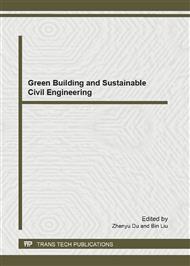p.50
p.55
p.59
p.64
p.70
p.75
p.80
p.84
p.90
The Study on Slope Stability Analysis Based on Finite Element Method
Abstract:
Slope stability represents an area of geotechnical analysis in which finite element method provides a lot of benefits over limit equilibrium. In this paper, the authors apply a finite element code, PLAXIS, on slope stability analysis with various conditions to state out sensitivities of not only the soil parameters, slope configuration and groundwater condition but also numerical condition that one would encounter when making a FE slope design. It demonstrates that slightly conservative safety factor is obtained using FEM over the ones from limit equilibrium method. Intensity of mesh for simulation domain shall be selected as a fine level for an acceptable accuracy and economical computation time. Element nodes slightly affect the result of safety factor and final deformation of the slope.
Info:
Periodical:
Pages:
70-74
Citation:
Online since:
October 2012
Authors:
Price:
Сopyright:
© 2012 Trans Tech Publications Ltd. All Rights Reserved
Share:
Citation:


